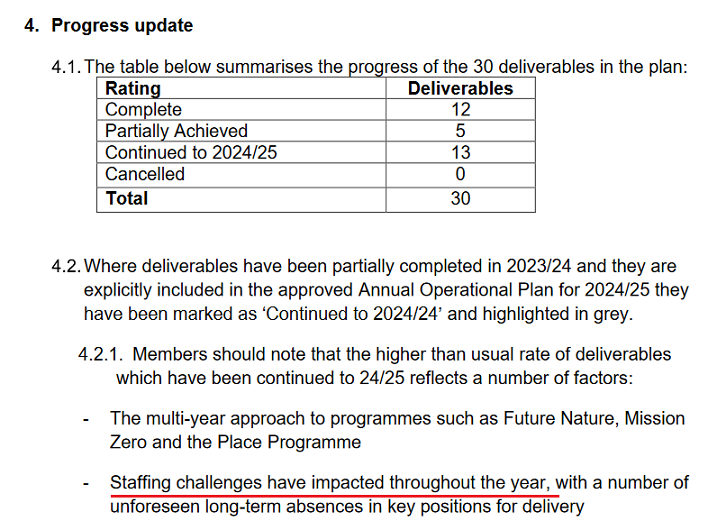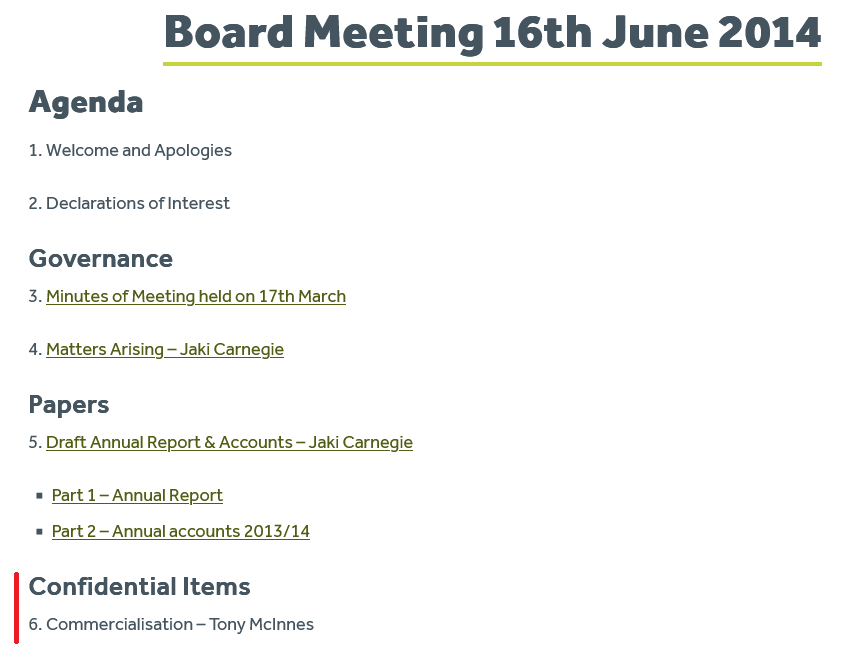The Flamingo Land planning application and the £2.4m investment Loch Lomond and Trossachs National Park Authority (LLTNPA) staff have agreed at the pierhead, which I considered in my last post (see here), is far from the only important issue facing the National Park Authority which is not on the agenda for the Board Meeting on Monday. Indeed the agenda and papers for the meeting (see here)are as notable for what they omit as for what they say. This post highlights a number of examples, focussing on some recently considered on Parkswatch.
The Cononish goldmine
After turning down a request from a member of the public to speak at the last meeting – which could have provided a different perspective to Board Members on the crisis at the mine (see here) to that offered by staff – during discussion it was suggested “that a site visit for understanding would be helpful if possible” before it was agreed:
“ACTION SM [Stuart Mearns] to look at possibility of organising a site visit to the gold and silver mine at Cononish for Members”
The Matters Arising for the June Board Meeting record this action as “closed”, without any mention of whether any visit took place or not, let alone which Board Members attended or whether anything was learned (I have submitted an information request). The key point here is that any visit will only have taken place after the sediment in Stack Number 2, which had been washing away into the river system over the winter, had been covered with matting and made secure (an action LLTNPA staff agreed last December but was still not complete at the time of the March Board Meeting). The time when the Board should have visited the site was in December, when there was a significant risk of a major environmental disaster, not May.
There is no other mention of the goldmine on the agenda, despite the fact that by the time of the next Board Meeting in September the mine will have been effectively abandoned for a year. Under the terms of the S75 Agreement by then the LLTNPA should be initiating steps to close the mine site completely and restore it, thereby re-opening the area for public access. It appears that decisions about this are being left totally in the hands of staff and they could now be working behind the scenes to mothball the site rather than restore it (see here).
The National Park Partnership Plan
There is nothing on the agenda about what to do about the National Park Partnership Plan which was approved by Lorna Slater shortly before she was sacked. Its targets for reducing carbon emissions were based on and depended on the Scottish Government meeting their own targets. Since the Scottish Government has now ditched those targets, the plan is effectively worthless and, as I argued in May, it is time for a reset (see here).
The fact that neither senior staff nor the Convener of the Board have thought fit to put their climate change targets on the agenda for the June Meeting confirms the plan was never anything but a worthless document (see here). Their lack of action suggests they never saw the plan as anything other than a cynical paper exercise to dupe the public and justify their own existence.
The costs and impact continued closure of the LLTNPA’s HQ at Carrochan
[Update: 10th June – I had missed fact that the Board Meeting was scheduled to take place in Carrochan and the video of the meeting today confirmed that was the case].
The section in the operational plan update for 2023/24 on “tackling the twin challenges of the global climate emergency and nature crisis” contains an official acknowledgement that the works to replace the biomass heating system and add solar panels to the roof of their HQ is months behind schedule:

There is no explanation, however, of why it was decided to change the specification from solar tiles to solar panels, an issue that should have been decided BEFORE the building contract was let or why the site was abandoned for a time by contractors (see here). So what is the financial cost of the delays both to the LLTNPA or to the other public sector organisations which occupied the building?
The operational plan update also reports that for last year a large number of other targets – renamed “deliverables” in the latest management speak – weren’t actually delivered:

There were two other factors listed, “Proactive delay to deliverables to enable other strategic priorities to progress” and “Challenges beyond our control” – not that dissimilar to “unforeseen long-term absences”! But were these factors unpredictable or were they a fairly predictable consequence of the botched management of the Carrochan re-fit? There is nothing in these reports that considers the human costs associated with staff being forced to work at home for far longer than planned.
After claiming that “Robust financial and budget management underpins the outcomes and
priorities of the National Park Partnership Plan”, the Finance Report proceeds to state in the next paragraph that “Turnover [staff presumably, not money?!] has continued to affect available capacity
and has particularly impacted on financial year end and other deadline driven work.” So its not just sickness, staff are leaving. Why? Could some of that also be linked to people being forced to work at home or is the whole ship sinking? Far from being robust, management of staffing in the LLTNPA appears to be falling apart.
Unlike the Cairngorms National Park Authority (CNPA), which has a resources committee to keep an eye of staffing issues, the LLTNPA delegates ALL responsibility for staffing to their Chief Executive, Gordon Watson. He decides everything, including the number and grade of posts, job descriptions, training and where and how staff work, without any democratic oversight. That is extremely dangerous. What appears to be a serious crisis in staffing has only been revealed because Mr Watson still has to explain to his Board once a quarter why the LLTNPA has failed to reach whatever watered down deliverables he proposes to them at the start of each financial year.
The confidential sessions of LLTNPA Board Meetings – in breach of legal requirements
It is quite possible that some of the issues I have raised above could be discussed during the “Confidential Session” of the Board Meeting which is scheduled for the afternoon. There is no way, however, for the public to tell as the LLTNPA gives no indication of what it intends to discuss during its confidential sessions.
Part III A of the Local Government (Scotland) Act 1973 applies to National Park Authorities and requires that, apart from specified exceptions, all business is conducted in public. In order to demonstrate adherence to the law, local and national park authorities used to give an indication of what they wanted to discuss in confidential session and then, at the start of the open part of a meeting, consider a resolution setting out the reasons for holding that business in private. This governance served to ensure that only matters which met the criteria set out in Park IIIA of the Act could be discussed in private.
Those criteria and that approach are incorporated into Annex 1 of the Standing Orders of the CNPA (see here):
“Where a resolution is passed to exclude the public on these grounds [nine are listed in the previous paragraph], the resolution must identify the proceedings affected, and state the reasons.”
The CNPA broadly still adheres to those Standing Orders even if this is not always clearly reflected in agendas and meeting. Those Standing Orders also require the Convener of the Board – NOT the Chief Executive! – to consider whether minutes of confidential sessions might be published in due course to cover the cases where the reason for secrecy is time-expired and the CNPA has, on occasion, done this.
The current Standing Orders of the LLTNPA contain no such provisions (see here) and delegate decisions about confidentiality to the “proper officer”, a member of staff The reasons for this appear to date back to the camping byelaws when the LLTNPA Board deliberated how to restrict access rights over the course of no less than 13 secret board meetings (see here) and (here). The Scottish Minister responsible for National Parks at the time, Aileen McLeod, connived with this and, having got away with it, it appears the LLTNPA started to ignore the law about the need for openness more generally.
The last time that I can find when the LLTNPA indicated on an agenda what it was they wanted to discuss in secret was ten years ago:

I later obtained a copy of that Commercialisation Strategy the LLTNPA adopted in 2014 – its never been repealed publicly – but since then the LLTNPA has made it as hard as possible for the public to know what subjects they are discussing in secret, although decisions to discuss (unnamed) subjects in confidential sessions have sometimes been recorded after that. For example, the minute of the March 2015 records:
“The Convener proposed that agenda items twenty-one and twenty-two would be handled as confidential items in closed session from which officers and members of the public would be excluded. DECISION: Members agreed to address agenda items twenty-one and
twenty-two as confidential agenda items.”
An example of fake governance, as there was no explanation of what section of the 1973 Act justified these items being discuss in public.
The last time the LLTNPA’s corporate risk register, which it is legally required to keep, was discussed in public was in 2017-18 (see here). Since neither the register nor the minutes of the meetings that consider it have published, there is no way for the public to know what risks the Board is considering let alone whether they are assessing and responding to them appropriately. What other matters are now, like corporate governance, routinely discussed in secret is also secret.
The need for a fundamental review of the governance of Scotland’s National Parks
This and may last post have considered the agenda and papers for the Board Meeting on Monday to illustrate some of the rottenness at the heart of the LLTNPA: the lack of transparency about investment decisions; the attempt by staff to muzzle what board members can ask about planning applications or do to help local constituents; the way agendas and papers are manipulated to ensure that key issues never get discussed in the public; the use of secret sessions to cover-up issues that senior staff cannot avoid but take to the Board; the failure to hold the Chief Executive to account.
The governance of the LLTNPA stinks and has done so for over ten years now. During that time the Scottish Government has shown no concern let alone take any action to address these failings. A General Election campaign should be a good time for candidates of ALL political parties to commit to remedy that. Calling on the Scottish Government to proceed with the second stage of the National Parks review, which it abandoned over ten years ago, and then setting out a reform programme for our two existing National Parks before creating any new ones would be a good place to start.
